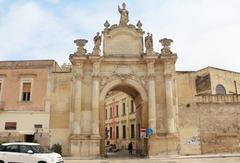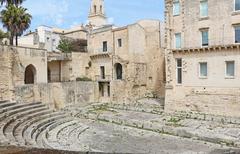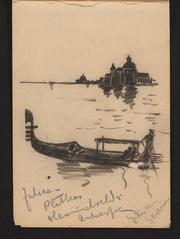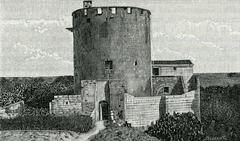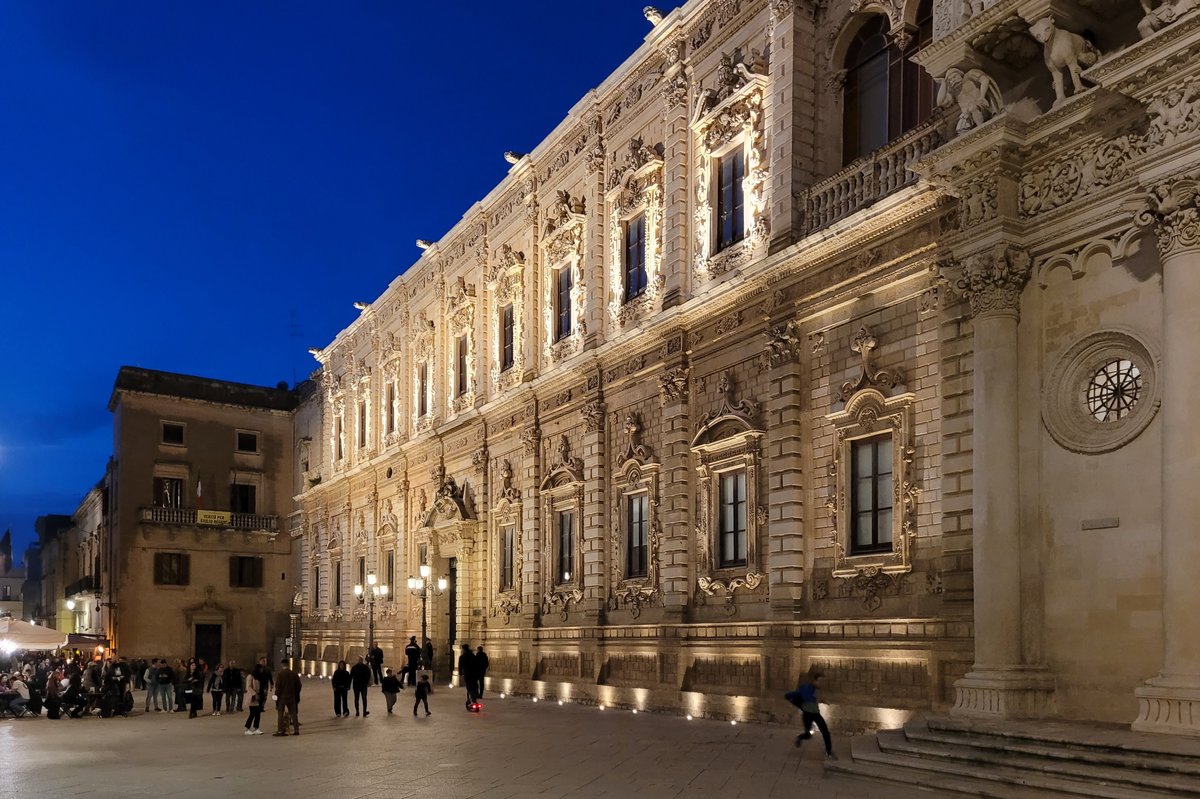
Visiting Palazzo dei Celestini in Lecce: Hours, Tickets, and Tips
Date: 01/08/2024
Introduction
Palazzo dei Celestini in Lecce, Italy, stands as a testament to the city’s rich historical and architectural heritage. This iconic landmark, a prime example of Renaissance and Baroque architecture, offers visitors a unique journey through centuries of history, art, and culture. The palace, originally constructed by the Celestine order in the 15th century, showcases intricate carvings and sculptures that reflect the artistic prowess of the period (initaly.wiki). Today, it houses the provincial government and serves as a cultural center, hosting exhibitions, events, and educational programs. Whether you’re searching for ‘Palazzo dei Celestini visiting hours’ or ‘Lecce historical sites,’ this comprehensive guide covers everything you need to know to plan an enriching visit. From historical insights and architectural significance to practical visitor information and nearby attractions, discover why Palazzo dei Celestini is a must-visit destination in Lecce.
Table of Contents
- [Introduction](#introductionintroduction)
- [History and Architectural Significance of Palazzo dei Celestini](#history-and-architectural-significance-of-palazzo-dei-celestinihistory-and-architectural-significance-of-palazzo-dei-celestini)
- [Historical Background](#historical-backgroundhistorical-background)
- [Architectural Evolution](#architectural-evolutionarchitectural-evolution)
- [Baroque Influence](#baroque-influencebaroque-influence)
- [Artistic Elements](#artistic-elementsartistic-elements)
- [The Archives and Library](#the-archives-and-librarythe-archives-and-library)
- [Visitor Information](#visitor-informationvisitor-information)
- [Visiting Hours and Tickets](#visiting-hours-and-ticketsvisiting-hours-and-tickets)
- [Travel Tips](#travel-tipstravel-tips)
- [Nearby Attractions](#nearby-attractionsnearby-attractions)
- [Conclusion](#conclusionconclusion)
- [FAQ](#faqfaq)
- [Call to Action](#call-to-actioncall-to-action)
History and Architectural Significance of Palazzo dei Celestini
Historical Background
The Palazzo dei Celestini, located in Lecce, Italy, is a significant historical and architectural landmark. The Celestine order, founded in the 13th century by Pope Celestine V, played a pivotal role in the development of this structure. The order arrived in Lecce in the 15th century and initially built the palace on the site of a previous monastery (initaly.wiki). The original monastery was established in 1352 by Gualtieri VI of Brienne, the Count of Lecce and Duke of Athens (Wikipedia).
In 1549, under the directive of Charles V, the monastery was relocated to its current site to make way for the expansion of Lecce’s fortifications (Wikipedia). The construction of the new complex began in the same year, designed by the architect Riccardi, who is credited with the original cloister and the portal of the adjoining Basilica of Santa Croce (Wikipedia).
Architectural Evolution
The Palazzo dei Celestini is a masterpiece of Renaissance architecture, completed in the 16th century. Its elegant facade is adorned with intricate carvings and sculptures, characteristic of the Renaissance style (initaly.wiki). The main entrance, topped by a graceful arch, leads to a spacious courtyard surrounded by elegant arcades. The arches are decorated with detailed carvings depicting various scenes from the life of Saint Celestine V, the founder of the Celestine order (initaly.wiki).
In the 17th century, the building was repurposed as a seminary, and in the 19th century, it served as a military barracks. By the 20th century, it had become a government building (initaly.wiki). Today, the Palazzo dei Celestini houses the provincial government, continuing its legacy of public service (pineqone.com).
Baroque Influence
The Palazzo dei Celestini is a stunning example of Baroque architecture, a style that flourished in Lecce during the 17th century. The facade is adorned with intricate carvings and decorative elements, showcasing the elaborate style typical of Lecce’s Baroque period (pineqone.com). The building is situated adjacent to the Basilica of Santa Croce, another architectural gem, making the area a significant cultural and historical landmark in the city (pineqone.com).
Artistic Elements
The courtyard of the Palazzo dei Celestini is a highlight for visitors, featuring delicate stone carvings that depict a variety of mythical creatures and floral motifs (initaly.wiki). The courtyard also provides a glimpse of the church of Santa Maria della Provvidenza, located at the back of the building. This small but exquisite church is decorated with beautiful frescoes depicting scenes from the life of the Virgin Mary (initaly.wiki).
The Archives and Library
The Palazzo dei Celestini is home to an extensive and historically significant archive, established in the 16th century to document the history of the Celestine order and its activities in Lecce and the surrounding region (initaly.wiki). Over the centuries, the archives have been enriched with documents from other religious orders, noble families, and government institutions. Today, the archives represent one of the most valuable and comprehensive sources for the study of the history of Lecce and the region of Salento. The collection includes manuscripts, parchment scrolls, maps, and photographs, providing detailed insights into the political, social, economic, and cultural history of the area (initaly.wiki).
The library of the Palazzo dei Celestini, founded in the 16th century by the Celestine monks, contains a collection of over 50,000 books, including many rare and valuable volumes (initaly.wiki). The collection covers a wide range of subjects, including theology, philosophy, history, literature, and science. The reading room, located in a beautiful room with vaulted ceilings and large windows, is a valuable resource for scholars and researchers from all over the world (initaly.wiki).
Visitor Information
Visiting Hours and Tickets
For those planning to visit the Palazzo dei Celestini, guided tours are available in English and Italian. Tours must be booked in advance by calling the Palazzo dei Celestini at +39 0832 24180 (initaly.wiki). Admission fees are €8 for adults, €5 for students and senior citizens, and free for children under 12 years of age (initaly.wiki). The visiting hours are from 9 AM to 6 PM, Monday through Saturday.
Travel Tips
- Best Times to Visit: The best time to visit Palazzo dei Celestini is during the spring and autumn months when the weather is pleasant, and the tourist crowds are smaller.
- How to Get There: The Palazzo dei Celestini is located in the heart of Lecce, within walking distance from other major attractions. Public transportation options, including buses and taxis, are readily available.
- Accessibility: The Palazzo dei Celestini is accessible to visitors with limited mobility. Wheelchair ramps and elevators are available.
Nearby Attractions
Lecce is a treasure trove of Baroque architecture, and the Palazzo dei Celestini is just one of many stunning examples. Visitors should also explore other Baroque churches and palaces in the city center, such as the Basilica di Santa Croce and the Palazzo del Governo (initaly.wiki). A short walk from the Palazzo dei Celestini is the Museo Provinciale Sigismondo Castromediano, which houses a collection of artifacts from the region’s history, including a Roman mosaic floor and a collection of medieval coins (initaly.wiki).
Conclusion
The Palazzo dei Celestini stands as a testament to the rich history and architectural prowess of Lecce. Its Renaissance and Baroque elements, combined with its historical significance, make it an essential destination for anyone visiting the city. Whether you are a history enthusiast, an architecture aficionado, or simply a curious traveler, the Palazzo dei Celestini offers a unique glimpse into the past and a chance to appreciate the artistic heritage of Lecce.
FAQ
What are the visiting hours for Palazzo dei Celestini?
The Palazzo dei Celestini is open from 9 AM to 6 PM, Monday through Saturday.
How much do tickets cost?
Admission fees are €8 for adults, €5 for students and senior citizens, and free for children under 12 years of age.
Can I book a guided tour?
Yes, guided tours are available in English and Italian. Tours must be booked in advance by calling the Palazzo dei Celestini at +39 0832 24180.
Is Palazzo dei Celestini accessible?
Yes, the Palazzo dei Celestini is accessible to visitors with limited mobility. Wheelchair ramps and elevators are available.
Call to Action
For an unforgettable experience of history and architecture, plan your visit to the Palazzo dei Celestini today! Don’t forget to check out other related posts on our website and follow us on social media for more travel tips and updates.


